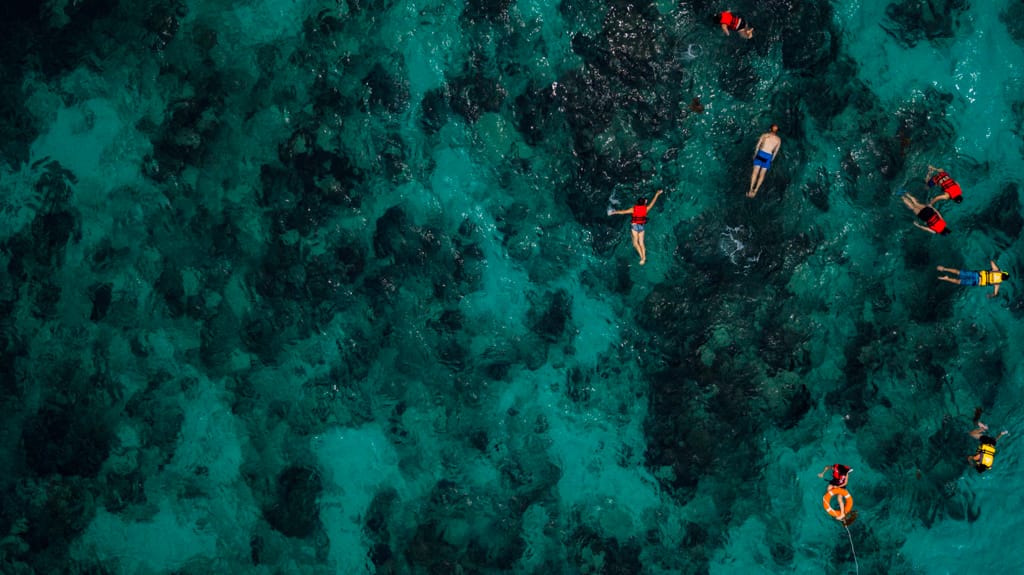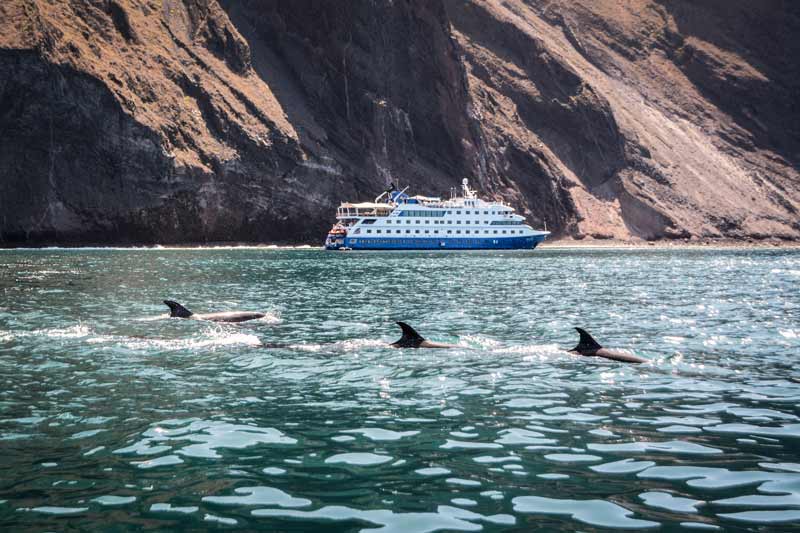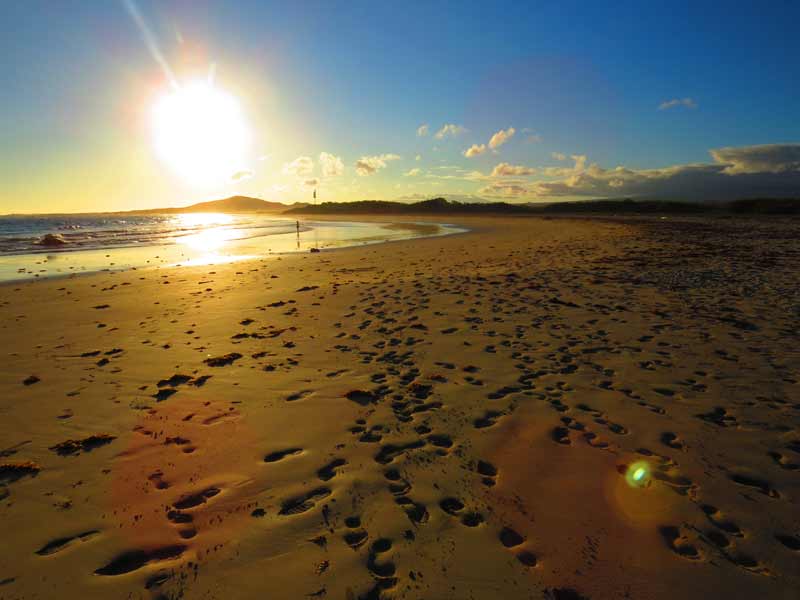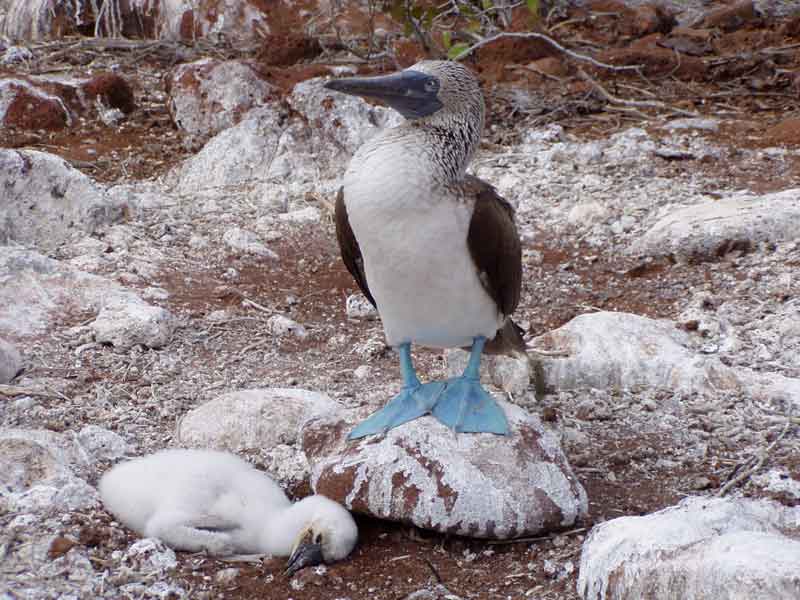
So you’ve decided to visit the Galapagos Islands, Ecuador’s natural wonder and one of the greatest nature-vacation spots in the world, huh? You are presumably now onto the next step in planning your trip: booking a tour. We put together a handy guide to help you through this step, which will mean thoroughly debating whether to island-hop or cruise through the famed archipelago!
You’re about to experience one of the most unique natural wonders of the world, and we know how important it is to make trip-planning simple and seamless! There are two ways of exploring the Galapagos Islands: island-hopping and by cruise. First, let’s be clear about the difference between these two. Island-hopping (also referred to as land-based) means you’ll be staying at hotels on the main islands, and doing day trips from there. A cruise involves you travelling on a boat during the duration of your trip, and the boat being your base for all activities (lodging, meals, excursions, etc.).
Our biggest recommendation for your decision-making process is to do your research and have a clear idea what you want to accomplish during your visit to the Galapagos. After all, the tour you choose should be driven by the trip you visualize for yourself (which islands and wildlife are a must-see, what pace you want to follow, how flexible you want to be). It all comes down to a matter of preference, so knowing what you want is key. Finally, we encourage you to keep in mind that careful planning is especially important during Galapagos high seasons, which are: 1) the last two weeks of April, 2) July to mid-September, and 3) the last two weeks of December. For cruises, the months of May and November are also considered high season, since many boats are on deck receiving maintenance.
Below, we break down the main parameters along which these two tour types vary: cost, accomodation, flexibility, range of visit (including wildlife sightings), activities, duration of trip, and overall comfort. To make the difference between these two tours even more clear, we go into further detail (including pros and cons) after. We hope this guide is as handy for you as it has been for all our travelers!
The main differences:
1. Cost
The cheaper option is definitely island-hopping. The all-inclusive nature of cruises makes their rates higher and less flexible. That said, the variety of cruises do suit different budgets, but even your cheapest option will be comparable or more expensive than an island-hopping itinerary. Island-hopping allows you to be more flexible with your budget, as you can choose which excursions and activities to engage in, and where to stay for any given day. For reference, a 5-day cruise can go anywhere from $ 2,000 – $ 4,000 or for last minutes $ 1,300 – $3,000, while a 5-day island-hopping tour ranges from $ 900 – $ 2,500.
2. Accomodation
The biggest difference here is that for cruises, your lodging (including meals!) will be on the boat, whereas for island-hopping you will stay at a hotel on one of the main islands. Lodging options in the islands range from hostels to high-end hotels, so again, island-hopping has more flexibility built into it. Cruises usually include the following accommodation categories: Luxury, First Class, Tourist Superior, and Tourist (and the main difference between these is of course, space and comfort). If you’re particular about space, be sure to inquire about specifics for your boat.
3. Flexibility
Flexibility is the main theme that runs through all these categories, and perhaps the most important factor marking the difference between island-hopping and cruise-based Galapagos tours. Simply put, when you book a cruise, you book a package deal — your schedule, excursions, and activities are pre-determined for you (and if you want to take the hassle out of planning, this can be a good thing!). With a cruise, the only thing you’ll get to decide is its duration. With island-hopping, you get to choose where to stay, what to do, when to do it, and at what pace (although it will take more planning on your end!).
4. Range of visit (islands and wildlife)
 The Galapagos archipelago consists of 13 major islands, 5 medium-sized islands, and 215 islets. Put simply, you’ll get to see a lot more of it by cruise. And because a cruise allows you to see more of it, you’ll also get to see more wildlife (both in the water and on land!). Cruises do most of their travel by night, so you’ll get to reach more remote areas that otherwise cannot be reached by day tour. Island-hopping means you’ll remain mainly in the three main islands (Santa Cruz, San Cristobal, and Isabela), and your visits to other islands are limited to those that can be reached during the day. Another important fact is that some places are restricted to cruise boats, making island-hopping a more limited way of experiencing Galapagos in their entirety!
The Galapagos archipelago consists of 13 major islands, 5 medium-sized islands, and 215 islets. Put simply, you’ll get to see a lot more of it by cruise. And because a cruise allows you to see more of it, you’ll also get to see more wildlife (both in the water and on land!). Cruises do most of their travel by night, so you’ll get to reach more remote areas that otherwise cannot be reached by day tour. Island-hopping means you’ll remain mainly in the three main islands (Santa Cruz, San Cristobal, and Isabela), and your visits to other islands are limited to those that can be reached during the day. Another important fact is that some places are restricted to cruise boats, making island-hopping a more limited way of experiencing Galapagos in their entirety!
5. Activities
Island-hopping offers a wider range of activities than cruises, and these activities tend to be more active and adventurous. Cruise-based excursions tend to be wildlife-focused, and you have more limited time for activities on land (such as hiking). Island-hopping gives you an opportunity to do a little bit of both, and to choose how adventurous you want the activity to be. The activities that are more available to island-hoppers are: hiking, cycling, surfing, kayaking, scuba diving, and snorkeling. Cruises don’t include as wide a range because of scheduling limitations, but also because activities have to accommodate all passengers (and not everyone has the same comfort level or physical ability to participate).
 6. Trip duration
6. Trip duration
Typically, cruises are 4,5,6,8, or 15 days long (there are very few in between). For reference, a semi-loop of the archipelago is 8 days, and a full loop is 15 days (but these terms can mean different things for each travel agency, so be sure to ask your travel expert about that). Island-hopping allows you to be more flexible in choosing the duration, although most travel companies have set itineraries that you can request to customize if you so wish. Another thing to consider is that cruises do maximize your range of visit on a shorter time frame — that is, you’ll get to see significantly more on a 4-day cruise than on a 4-day island-hopping tour.
 7. Seasickness and overall comfort
7. Seasickness and overall comfort
Seasickness is a real concern for cruise-goers. The smaller your boat, the more likely you are to experience it. If you’re never been on a boat for prolonged periods before, consider a larger vessel and come prepared with any medications that might offset the motion sickness. Additionally, keep in mind that space on cruises will be much more limited than on the islands (the exception being a luxury cruise with spacious cabins). Know your comfort levels and remember that on cruises, you will be confined to one boat and the same people the entire time. This also means that your amenities will also be more limited (no WiFi, and fewer food options, for example).
Now we’ve giving you the big-picture comparison between island-hopping and cruises on the Galapagos Islands, you can read about the basic characteristics, including pros and cons of each, below:
ISLAND-HOPPING (LAND-BASED) TOURS
The main islands from which to island-hop are Santa Cruz, San Cristobal, and Isabela. You can stay overnight at any of these (or all three), and go on excursions from here during the day. Island-hopping tours usually include transportation by water (day trips) and over land. Although it is possible to book day tours independently once you arrive, your options will be much more limited, as some islands have limited visits per day and availability depends on season.
Pros of island-hopping:
- Cheaper
- More flexibility to choose your schedule and pace
- More activities to choose from, and more active ones
- More possibilities of interacting with locals and other travelers
- More time on land
Cons of island-hopping:
- You won’t get to see as much (including those places that are remote and only accessible by cruise)
- Less time spent exploring (because some of your daytime will be spent in transit)
See some of our land-based tours: Galapagos on a budget: 4 day experience, 5 day experience, 6 day experience, 8 day full experience.
CRUISE-BASED TOURS
Cruises are an all-inclusive deal that have you covered from the moment you step foot on the boat. There are a variety of class options to choose from (Tourist to First Class boats). Cruises will do most of their travel at night, so that during the day you can maximize time for exploring and activities. The size of cruise boats ranges from 12-16 person yachts to larger boats suited for up to 100 passengers (and so does the cost, accordingly). Remember that cruises aren’t always synonymous with luxury or quality travel. Make sure you do your research on the company you are considering, so your trip isn’t full of unpleasant surprises!
Pros of cruises:
- Efficient itineraries – pre-planned and maximize daytime
- You’ll get to see more – more islands, more remote areas, more wildlife
- Guided throughout the duration of your trip
- All-inclusive (food, activities, excursions)
Cons of cruises:
- Possibility of seasickness
- No flexibility or independence – everything is planned
- You’ll be confined to the same people and space for the duration of your stay
- Tends to feel more fast-paced (although activities are less strenuous because they need to accommodate the larger group)
With the proper balance of planning, research, and self-awareness, you’ll be on track to booking your ideal trip to the Galapagos! Feel free to message us directly for any questions, and for more information on the tours we offer.
Happy travels!
